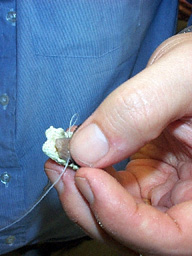These corals can usually be cut using a sharp razor blade. These cuttings will secrete a lot of slime. Manipulating them will be difficult so be certain to start with a cutting that is at least a couple of inches long and has some smooth stem. This will also allow for the inevitable shrinkage that the coral frag will undergo once it has been cut. The sinularias can recover nicely from having a entire branch removed. The heads of sacrophytons can be cut into pie shaped sections. Be sure to include a length of stem to make attachment easier. The gap left by a slice will eventually close.
Crazy glue (cyanoacrylate) can be used to attach soft coral frags to the base rock. The best glues to use are the quick setting thicker gels. Ross's Lock Tight has been recommended. For lasting adhesion both surfaces should be dry. Place glue on the rock and the stem. Hold the longitudinal length of the stem or cutting to the rock surface until the are secured together. The branch needn't be upright. When it is positioned in the tank it will grow towards the light.
Soft corals can also be sewn and tied to rocks. Use thicker string or twine, not fishing line. The plastic lines are too sharp and will slice the coral as it expands when fragmentation is complete. A needle and thread can be used to puncture the coral flesh and wrap the thread around the frag and rock. Do not tie it down too tightly though. Again, attach the long part of the stem, not the base.

In a day and age when the survival of coral reefs is in question it becomes vitally important for all coral enthusiasts, academia, divers and aquariasts alike, to assume their responsibility in the conservation of these natural wonders. Propagating our corals is one very big step in the right direction. Take pride in your garden, reap it's harvest and share it with others through propagation.
Join an aquarium society today or start one if your community does not already have one in operation. The sharing of knowledge and expenses as in this propagaion exercise will make it all worthwhile.